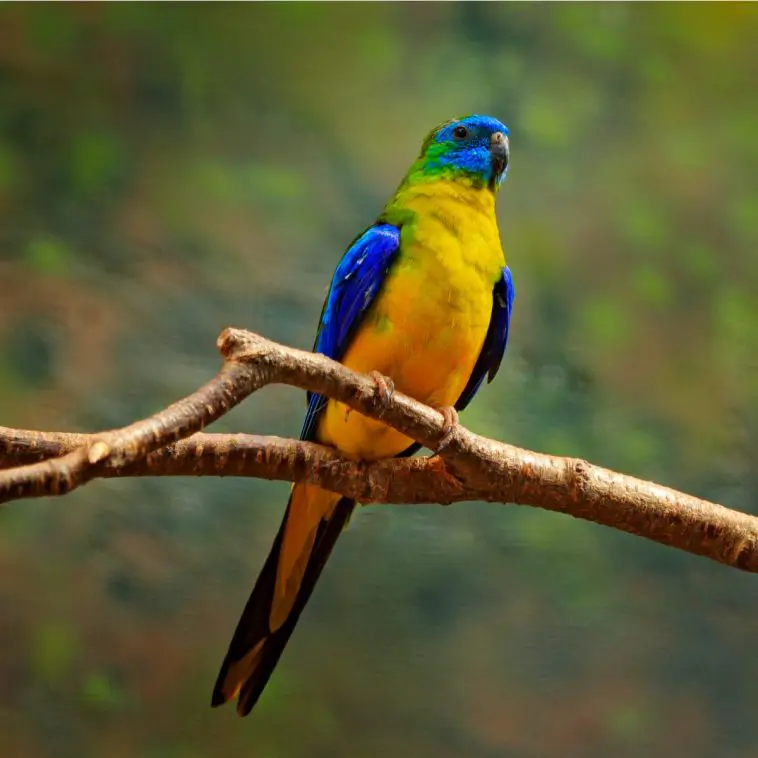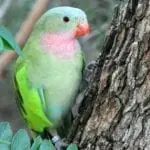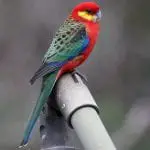Scientific Facts
| Scientific name | Neophema pulchella |
| Kingdom | Animalia |
| Class | Aves |
| Phylum | Chordata |
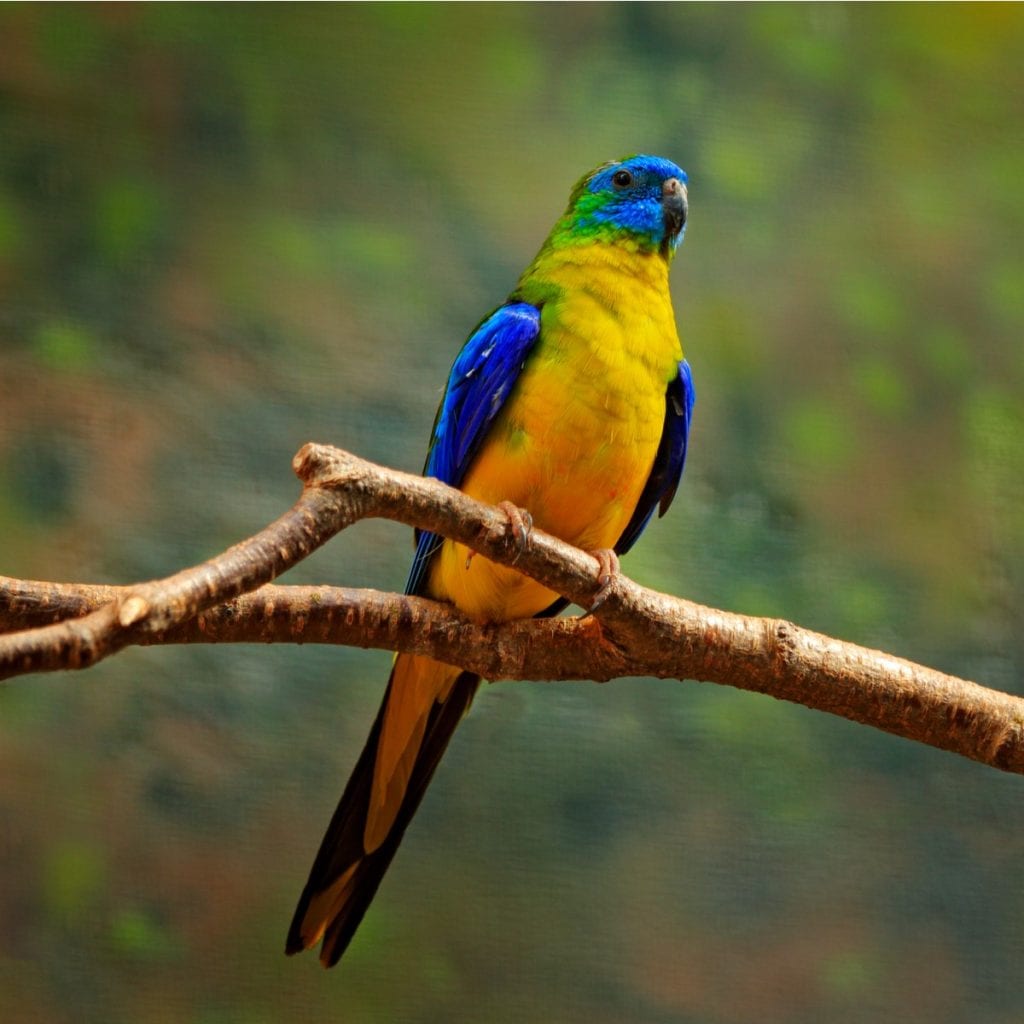
Description
Reaching from 20 near 22 cm (8–83⁄4 in) extended through a 32 cm (12 1⁄2 in) wingspan, the turquoise parrot is a minor and slightly constructed parrot considering about 40 g (1 1⁄2 oz). Equally, sexes have mainly jade upperparts besides creamy underparts. The version of the male has a cheerful turquoise-blue appearance, which is dimmest on the top and somewhat lighter on the lores, galls, and ear copses. The neckline then upperparts are grass-jade, and the end is grass-jade with creamy borders. The arm seems bright azure with a dimmer foremost edge when creased, with a posse of pink on the upper part. The underparts are lively beige, somewhat greenish on the breast besides neckline.
Approximately males have carroty covers on the stomach, which might range to the breast. Once stretched, the wing is dim azure with pink on the sprawling edge on the higher exterior, and dark with dark azure leading copses beneath. The upper jaw of the bill is dark and might or might not disappear to old at the base, though the lower jaw is cream with a gray edge in the entrance. The cere then orbital eye-ring is gray then the iris is dark russet. The limbs besides feet are gray.
Usually duller and lighter, the female has a supplementary unchanging and paler azure appearance, with extremely conflicting cream simple casing about the eye. Its absences the pink shoulder posse, and the navy shoulder patterns are dimmer and less separate. The gullet and torso are pale jade, and the stomach is creamy. The upper jaw is lighter chocolate-grey with a dimmer tip, then has been logged as dark though nesting. The inferior jaw is light grey to nearly white. Once hovering, the female version has a comprehensive snowy bar noticeable on her underwing.
Youthful birds of equal sexes have fewer wide-ranging cobalt on their appearances, the pattern not spreading past the upperparts. The upperparts look like those of the mature female. Together sexes consume the snowy wing-strip, which vanishes with adulthood in males. The young male has a pink cover on the arm and might also have a carroty wash on the stomach.
Distribution and habitat
The turquoise parrot is originated in the hills of the Great Dividing Range besides nearby parts. The northern boundary of its variety is 26° south in southeastern Queensland, about Cooloola, Blackbutt, besides Chinchilla, spreading westwards to the neighborhood of St George. Beforehand 1945, it had been chronicled as distant northern as the Suttor River then Mackay. In New South Wales, it is originated in a comprehensive band crossway the dominant and eastern shares of the national, with its western bounds defined by Moree, Quambone, Hillston, Narrandera, besides Deniliquin. There have been unverified detections in the distant west of the public. In Victoria, it is originated in the neighborhood of Wangaratta along with East Gippsland and about Mallacoota. Detections in South Australia are probable to consume been the scarlet-chested parrot, the alike arrival of the females foremost to misperception besides misidentification.
The turquoise parrot dwells open forest and grassland forest collected either of innate cypress (Callitris species) or eucalypts, chiefly silver box (Eucalyptus albums), creamy box (E. melliodora), Blakely’s pink gum (E. blakelyi), pink box (E. polyanthemos), scarlet stringybark (E. macrorhyncha), bimble box (E. populnea), as well as mugga ironbark (E. sideroxylon), besides less usually Angophora close Sydney, silver top ash woodland (E. sieberi) in Nadgee Nature Reserve, then stands of stream red gum (E. camaldulensis), crag marsh gum (E. camphora) or western gray box (E. microcarpa) in compliment more open parts. Inside this home, it favors rocky edges or gorges, or provisional areas among different homes, for example, among wood and savannah or arenas in refined zones.
The turquoise parrot is careful inactive and does not travel, though its actions are not well recognized. Birds are current in some parts all year; however, in northern Victoria, they are supposed to change into more exposed parts outside the breeding period. Some inhabitants might be locally itinerant, following obtainability of liquid.
Conservation status
About 90% of the turquoise parrot populace exists in New South Wales. The type is not registered as endangered on the Commonwealth Environment Protection and Biodiversity Conservation Act 1999, however a rank of near endangered was future by Stephen Garnett, then Gabriel Crowley in their 2000 labor The Action Plan for Australian Birds on the explanation of the important reduction in circulation.
Its populace and variety have wide-ranging madly; widely dispersed athwart eastern Australia after Mackay to Melbourne equal to the 1880s, it disappeared from much of its variety to the degree that it was supposed nonexistent in 1915. It was not logged from Queensland among 1923 and 1950, besides Victoria amid the mid-1880s, then 1949. Though statistics in New South Wales started cumulative in the 1930s and the class had repopulated East Gippsland by the 1960s. Hesitantly projected at 20,000 breeding natures in 2000, the populace is supposed to be still increasing.
Behavior
Turquoise parrots are come across in couples or small clusters entailing of parents besides numerous offspring; however, they may assemble into greater herds of equal to 75, mainly young natures outside the breeding period. As the upbringing period nears, couples distinct out from these herds. Turquoise parrots perch together mutually in fall and season. At nightly they perch among the greenery of vegetations, for example, gums or wattles, wherever from 1 to 8 m (3–25 ft) overhead the ground. The flight to foliage near their nourishing parts throughout the day. The noises of the turquoise parrot have remained little-deliberate; birds stretch a high-inclined soft interaction call when nourishing or in aeronautical, though the alarm noise has been labeled as a high-inclined zitting noise. Turquoise parrots likewise talk when relaxing to perch in the dusk.
Breeding
The turquoise parrot is committed. The male roosts standing on a tree base and spreads its wings to display off its pink and blue patterns when seeing a female. Once paired, equally sexes guise for a nesting location, which is finally selected by the female. Breeding has been described on or after Girraween National Park on the New South Wales–Queensland edge in the northern to Wangaratta, then Mallacoota in Victoria. Fowls usage vertical or closely vertical craters of live and deceased vegetations, usually eucalypts, as nesting locations. Infrequently old barrier poles have continued used. The turquoise parrot challenges with—and might be expatriate by—the eastern rosella (Platycercus eximius), red-rumped parrot (Psephotus haematonotus) formerly russet treecreeper (Climacteris Picumnus) for suitable breeding locations. The seedling covering the resonating is frequently situated in open forest, besides the hollow itself is usually as a minimum 1 m (3 ft) overhead the ground. Research in north Victoria produced regular sizes of 10 by 6 cm (4 by 3 in) for the deep arrival, and complexity of about 50 cm (20 in) for the complexity of the fleabag. Elsewhere the regular deepness is about 76 cm (30 in).
Breeding takes dwelling completed the warmer months with offspring placed from August to January. The clutch is placed on a bed of timber dust or greeneries and contains 2 to 5 (or infrequently up to 8) rounded or oval sleek white offspring, each of which is usually 21 to 22 mm extended by 18 mm (0.8 by 0.7 in) extensive. Clutches incline to have additional spawns in previous somewhat than advanced clutches, and in shells situated further from empty terrestrial. Eggs are placed at an intermission of 2 to 3 days. Development takes eighteen to 21 days. The version of the female hatches the eggs and young the new, and foods them for their primary limited days beforehand the male starts serving. She leaves to fodder and drinks double a day, as soon as in the before noon, and as soon as in the after lunch.
Both parentages take a share in feeding the new, on food mainly of kernels with some berry. The hatchlings are altricial then nidicolous; that is, they are instinctive stranded then blind and continue in the shell for a lengthy period. Enclosed in the silvery-snowy down, they consume flushed skin then dimmer blue-grey casing about the eye. By 7 days, they start to open their eyes, besides are well-enclosed in grey down with jot downs developing from their extensions on day 6. They are nearly enclosed in fluffs by day 21, then fledge (leave the shell) at about 23 days of the stage in the rough and equal to 30 days of the stage in confinement.
About 56% of eggs main to fruitful fledging of new, with research in northeastern Victoria yielding a regular of 2.77 new leaving the shell. The lace display (Varanus varius) then red fox (Vulpes vulpes) are shell killers. Baby birds might die by hotness in a very hot climate, or by being sunk in the craters after substantial rain.
Aviculture
Originally general as a confined fowl in the 19th period, the turquoise parrot was infrequently seen in confinement amid 1928 and 1956, the chief issue being the high degree of infertile spawns. It has to turn out to be more mutual meanwhile and has modified eagerly to aviculture. A silent type, it likes to wash in confinement. There is an option of breeding with other adherents of the type Neophema if confined together. Examples with more protuberant carroty bellies have remained bred, obtained from rough birds in New South Wales, then not after breeding with scarlet-chested parrots. A creamy system, where the azure color is lost besides creamy and pink colors are preserved, first seemed in the 1950s in aviculture. It is a receding change. Additional color formulae perceived are a red-fronted besides pied procedure (both receding), and jade then olive (leading).
Fun facts
The yellow change is the greatest general, even further so than the unique pattern. Further turquoise changes comprise opaline, filled red-fronted besides cinnamon.
The Turquoisines part the similar quiet, mild, appealing, sociable character of the further grass keets that I take and kept in my birdcages over the ages.
The part many bodily structures with the Scarlet-chested parakeet, nonetheless, have a slightly diverse character. They are single of the greatest vigorous grass parakeets, continuously moving about their flying from hovering to running or rummaging for nourishment.
These parakeets are likewise mature unhurried than the further grassroots. Though they can breed as 1-year old, they are healthier parentages by the stage of 2 years old. It is finest to distinct fledglings from their parentages as rapidly as they consume on their own, as males might display violence towards their lads.
Common health issues
Psittacine Wasting Disease
Psittacine Wasting Disease is thought to be virus-related and is understood most frequently in Macaws. The disease commences with sickness and other stomach indications, then proceeds to overall faintness and fast weight loss. The analysis is completed through the operation of the abdominal. This illness usually consequences in demise.
Psittacosis
Psittacosis or Parrot Fever is a communicable illness that is also transmissible to humans. Pretentious birds display a diversity of indications, counting respiratory problems, tearful or runny eyes, sneezing, then cramming. Respiratory contaminations can avert breathing. Psittacosis can likewise main to liver illness and demise. Psittacosis has the aptitude to hatch without indications for ages, making it likely for an ill bird to look fit. Fecal examinations are used to identify this illness; nonetheless, birds shed the bacterium at breaks, so an examination might fail to notice the illness. Both pretentious and natural birds can feast the illness-causing creature.
When analyzed, affected birds, besides birds contained close them, are isolated and treated with antibiotics. People ill with this illness typically display flu-like indications; nonetheless, this disease can be much further grave in people with compromised immune systems. Since Psittacosis can be conveyed to people, all cases of contagions in birds must be stated to health administrators.
Aspergillosis
Aspergillosis is a respiratory illness of birds produced by yeast. This mold is current in the situation and is typically not problematic for a fit bird kept in a spotless situation. Affected birds display loss of hunger, recurrent drinking besides urination, besides severe respiratory complications. Surgery might be essential to eliminate the cuts. Antifungal medications are typically prearranged in conjunction with helpful care, for example, oxygen besides tube feeding. The analysis is completed through blood examinations, X-rays, then endoscopy. Aspergillosis is frequently deadly.
Psittacine Beak and Feather Disease
Psittacine Beak and Feather Disease is an extremely transmissible viral contagion initially found in Cockatoos; nonetheless, it is transmissible to entirely parrots. This disorder fallouts in abnormal plume growth and beak development. Over period affected birds drop their feathers. As the illness progress, the beaks of sick birds raise unusually and form diverse coatings, often subsequent in pain that might reduce the bird powerless to eat. There is no action or vaccine obtainable for this illness.
Pacheco’s Disease
Pacheco’s Disease is an extremely transmissible disease amid parrots produced by a herpes disease. This virus bouts the liver and is deadly. Further than provision care, no action is obtainable for affected birds; nevertheless, unprotected birds can be agreed antiviral medicine to help stop the feast. There is no inoculation for Pacheco’s Disease.
Quill plucking
Quill plucking, though not an illness, is a grave health issue mutual in parrots. The details a parrot resolves or plugs its fluffs are so compound, and the medicines so many, it is unbearable to shelter them and still address additional health matters. Nutrition, aversions, moisture issues, shock, and a complete host of social and communal issues influence into plume plucking. Refer your avian vet to exchange about this issue if you see your fowl munching or removing its fluffs.
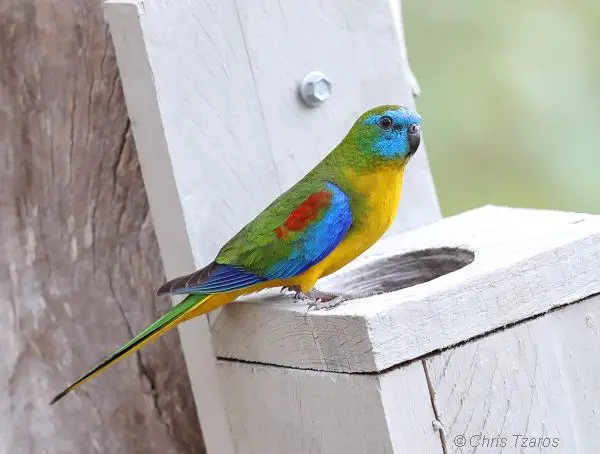
Care sheet
- Stopping tedium in parrots
- House in the main birdcage likely
- Let them out of the birdcage often, preferably letting them free flying
- Deliver a diversity of toys and alternate them on a regular base. Toys obtainable must be parrot harmless and allowed from any dyes, lacquers, or metals, which might be poisonous.
- Move the birdcage around to alter their assessment of the area
- Deliver comestible fruit sapling twigs with differing widths as roosts. This, too, helps stop compression wounds on their feet.
- Make certain they aren’t unaided for long ages
- Insufficient care from owners or in some cases, excessively!
- In every social class, for example, the Budgerigar and Cockatiel (either house in couples or deliver with a glass or a malleable replica fowl)
Foraging and Feeding
In the barren parrots, give a big portion of their day hunting for nutrition. It is a decent idea to list exact nourishing times and to rouse scavenging action.
Parrots love to extinguish belongings besides this wish can be used by making modest cheap scavenging toys. Some thoughts are hanging chains with berry and vegetables knotted in and wooden boxes full of torn paper and their favorite nourishments; you can become as imaginative as you want! Make certain your fowl is overseen throughout the destructive show.
Photoperiod
Entirely birds must have a time of light on or after 8-12 hrs. It is counseled to shelter the birdcage for a minimum of 10 hours in the evening.
UVB light
UVB is an indispensable share of sunlight that aids birds change vitamins into their vigorous procedures. Placing the birdcage after an opening does not effort as the glass sieves out the helpful UVB from sunshine. Significantly, our domesticated birds obtain UVB from fake sun up-lighters. These especially covered fluorescent tube decorations and solid bird lamps deliver the precise stages of UVA besides UVB, which recover your parrot’s fitness, hunger, feather illness, and further. They can be assigned to the bird’s cage then swapped on for 10 hours a day.
Bathing
Let your parrot to either wash in low water or be squirted day-to-day.
Particularly valued by African grey parrots who incline to get very dirty.
Privacy
A dim box must be given as a ’hide’ into which the fowl can arrive and feel safe.
Some recurrent reasons for behavioral subjects
Vicissitudes to their even routine may consequence in unpredictability, neurosis, or other social difficulties.
Behavioral difficulties frequently relate to monotony or worry situations (neurosis); nonetheless, another activates might be due to turbulences or vicissitudes at household, which may worry the fowl such as:
- A new move
- Additions to the household, recurrent companies or another domesticated in a similar house
- Recurrent urgings within the household
- Extended stages absent from the holder
Availability and where to get one
It is important that you only get such kind of bird from a legit pet shop that caters to birds and all. It will also give you a heads up to get in touch with your local aviaries owners and vets.
FAQs
How do you pay attention to your parrots?
- Tend to the birdcage bottommost every 2 days. Eliminate any linings and substitute them, and abandon any shells, kernels, grit, dolls that are demolished, etc.
- Unsoiled and change the nourishment and liquid dishes every day.
- Call the vet on a steady timetable.
- Watch for fitness difficulties.
What do you fodder a sick parrot?
At large, you need to deliver a big diversity of fresh nourishment for your fowl. Characteristically, I indorse a core food of a biological and hue free parrot pellet. Big diversity of fresh vegetables must be provided for equally nourishment and mental encouragement. A small number of kernels can be provided as a delicacy.
What is Parrot Preferred food?
These birds are omnivores, meaning that they can consume equally meat then vegetation. Most parrots have food that covers nuts, plants, fruit, sprouts, stones, and insects. Kernels are their preferred nourishment. They have robust jaws that let them snap open husks to get to the kernel that’s inside.
Are parrots tough to take care of?
If you’ve not ever even possessed a fowl beforehand, formerly, a parrot is not for you. These birds are just as tough if not tougher to take maintenance of than pooches or felines; they are one of the added high care birds to retain as a domesticated animal. … Not only that, nonetheless, parrots are actual, very flamboyant animals then can shriek at any assumed period for any assumed motive.

